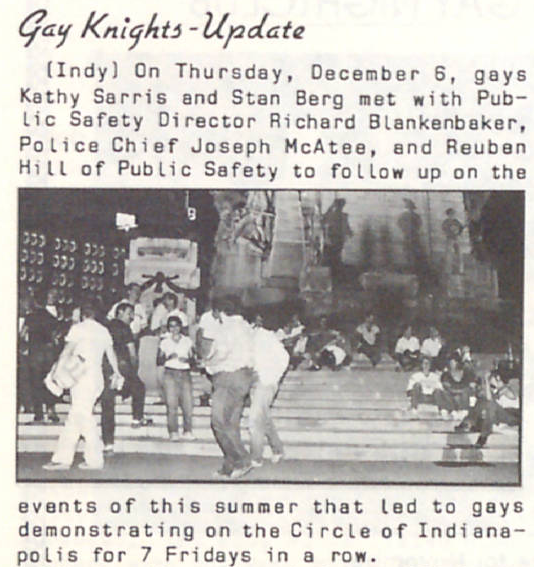
Heart racing, 31-year-old Steven Ott escaped the aggression of his companion, whom he met at Our Place (now Greg’s), by jumping out of the car near 34th and Georgetown Road. He fled to a nearby Taco Bell and ran towards three Indianapolis Police Department (IPD) cars parked in its lot. Ott recounted the frightening experience to the officers, who offered to call him a cab, but refused to do anything about the assault.
“Faggot,” stated one of the officers as Ott waited for his cab. Ott took down the license plate number of the offending officer only to be arrested. According to Ott, when asked why he was being arrested he never received a reply. He spent the night in Marion County’s jail and when he appeared before a judge the next morning he was told simply “that he could go—no hearing, no formal charges.” Reportedly, the officers initially charged Ott with public intoxication, although they never filed an affidavit with the court. [1]
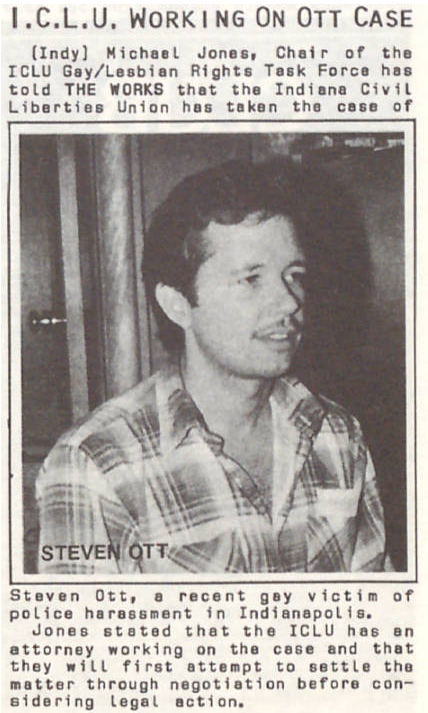
Indianapolis’s LGBTQ community encountered and protested numerous challenges posed by law enforcement in the 1980s, including police surveillance of cruising sites, harassment at safe spaces, and possible prejudiced police work as homicide rates increased for gay men. Bars served as a popular safe space or third space environment where members of the queer community could socialize. But they were also the site of harassment, surveillance, and violence. Gay rights activist Mike Stotler recounted police harassment at Terre Haute’s gay bar, R-Place. [2] He reported “You can be in the bar for maybe just one hour, and be asked to present ID to a police officer four or five times. The police also routinely copy down license plate numbers in an attempt to intimidate the bar’s patrons.” Stotler also described violent harassment, stating that one man en route to R-Place alleged that two police officers picked him up, drove him from the bar, and beat and verbally assaulted him. Despite broken ribs and a hospital stay, “The victim has so far been afraid to report the crime, for fear of losing his job and coming out to his family.”
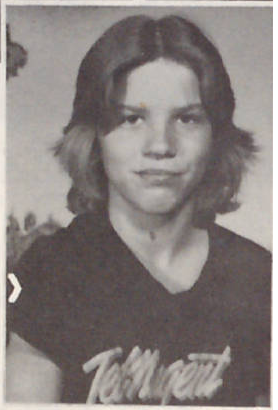
Mistrust of police following such encounters would stymie efforts to solve a string of murders, tracked back to 1980 but most likely earlier (either not reported by the news or not explicitly stating the victims were associated with an LGBTQ identity). There was fifteen-year-old Michael Petree, murdered in 1980 and left in a ditch in Hamilton County. [3] Then it was twenty-five-year-old Gary Davis, murdered in 1981 on the Southside of Indianapolis. [4] The following year, twenty-six-year-old Dennis Brotzge was murdered on the Northside of Indianapolis. [5] The body of Delvoyd Baker, an eighth-grader who was last seen in an area of Monument Circle known for prostitution, was found in a ditch in Fishers. [6] With his death, police ramped up efforts to find the perpetrator. Police Chief Joseph G. McAtee stated, “I believe as chief of police when a 14-year-old boy gets picked up downtown and murdered, and young teen agers are getting money for prostitution on the Circle, we have an obligation not to let this happen to our young people.”

However, president of LGBTQ civil rights organization Justice Inc. Wally Paynter told The Indianapolis News in 1998, “‘The police put this on the back burner. They didn’t discuss it across jurisdictional lines. . . . If these had been CEOs’ bodies scattered across the community, there would have been a manhunt the likes of which you had not seen.'” Out & About Indiana author Bruce Seybert had a different take and told the News that he believed “some police officers honestly didn’t know how to plug into the gay community for help, but that they learned along the way and established longer-term contacts because of the investigation.” [7] Regardless of the extent of their efforts, police found questioning possible witnesses “extremely difficult” due to LGBTQ mistrust of the police. [8] This led the police to a new strategy—surveillance of cruising sites. Police undertook surveillance in the hopes of deterring similar crimes and catching the perpetrator, but also to “cut down prostitution, assaults and harassment of tourists.” [9]
In an era before dating apps, cruising sites provided common areas where LGBTQ members could congregate and meet other people. They tended to be associated with gay men gathering with the intention of a sexual encounter. In an article about why homosexual men took part in cruising, the New York Times quoted an anonymous participant, who stated “Society doesn’t accept us and it’s hard to meet people, sexually or socially.” In Indiana, areas like the downtown public library branch, Monument Circle, Fall Creek, and Skiles Test served as common cruising sites. In addition to surveillance, police went undercover in an attempt to arrest men for breaking “vice laws.” These efforts furthered suspicion of police motives among the queer community, especially because some officers conflated prostitution with homosexuality. With announcement of surveillance following Delvoyd Baker’s murder, the LGBTQ community expressed concerns that police would violate their rights by filming patrons frequenting gay bars, the videotapes of which police promised to make available to the public.
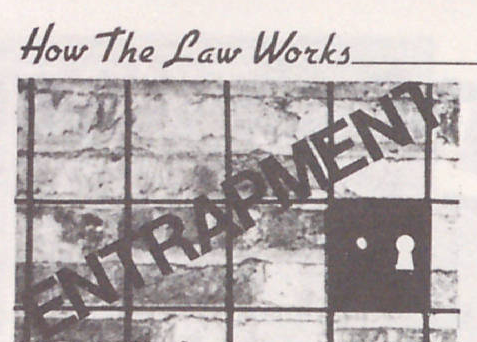
In 1983, at the initiative of the queer community, leaders of the Indianapolis Gay/Lesbian Coalition (IGLC)—comprised of fourteen educational, religious, political, business, and social organizations—met with police officials to volunteer their help in solving the murders and improve relations with the IPD. They also made seven recommendations to police, including establishing a liaison to communicate with the homosexual community; cease video surveillance; train officers to be more sensitive in their interactions with the LGBTQ community; and educate the police force about homosexuality. Public Safety Director Richard Blankenship noted that the meeting “‘opened the door to better communication between gays and the Department of Public Safety. . . . We feel we can resolve our problems much quicker and more effectively than we have in the past.'” [10]
IGLC made progress in opening a line of communication between law enforcement and the queer community, which in turn may have improved efforts to solve gay-related homicides. This progress was intermittent however, and Stan Berg reminded readers of The Works “We must remember the conservative political and sexual climate of Indiana.” [11] In 1984, plainclothes policemen wrongly accused gay men of prostitution, an incident IPD officials described as “well-motivated but unfortunate.” [12] Three LGBTQ organizations in Indianapolis, as well as those in Muncie, Columbus, and Bloomington, either attended or endorsed a press conference denouncing harassment and the resumption of video surveillance. Twenty-three individuals issued harassment complaints with the Indiana Civil Liberties Union. One of these was David Molden, who claimed officers choked and slapped him during his arrest for using false identification. [13]
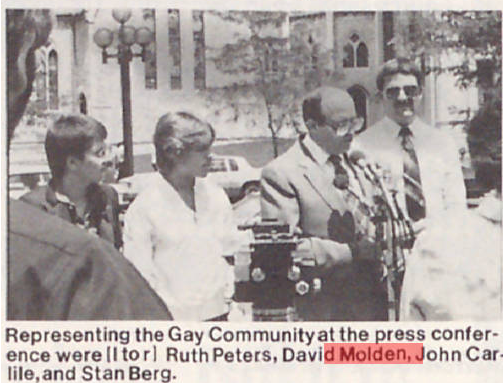
The New Works News noted in 1988 that, again at the initiative of the queer community rather than police officials, the IPD and LGBTQ community came together regarding a string of robberies of Indianapolis gay bars. Detective Don Wright invited representatives from all of the affected bars, as well as victims and witnesses. The New Works News described the meeting’s turnout as “heartening” and that “Each of the victims present at the meeting was asked to tell their version of the incident in which they were involved. All did so in detail and apparently in all of the incidents the attitude and discretion of the responding officers was exemplary, with one exception.” [14]
Detectives at the meeting pledged to dispatch more plainclothes officers at the affected businesses to deter future robberies. The LGBTQ community’s earlier efforts to help the IPD solve LGBTQ-related murders resulted in this more collaborative spirit. It is unclear if their assistance helped the police investigation, as some of the murders were not solved until 1998 with the discovery of Westfield serial killer Herbert Baumeister. In the case of some victims, police never identified the perpetrator. However, the murders resulted into closer communication between the queer community and the IPD.
As with most efforts to secure civil rights, progress for the queer community in the city known for its “Polite Protest” and “Hoosier Hospitality” occurred in fits and spurts. Indiana’s 2015 Religious Freedom Restoration Act signaled that the struggle for LGBTQ rights in the U.S. endured into the 21st Century. However, the efforts of the IGLC and the Indiana Civil Liberties Union in the 1980s removed some of the stigma in seeking recourse against discrimination.
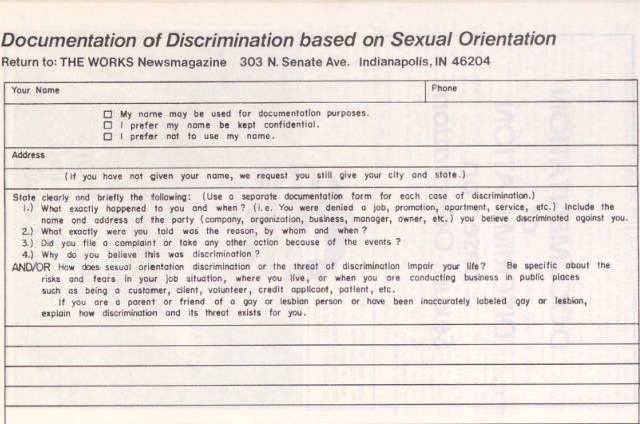
A note on sources:
This piece used materials gathered by Indiana Landmarks’ Central Indiana LGBTQ Historic Structures & Sites Survey, a project to compile information associated with Indianapolis-area queer history, architecture, and places. The research materials have been provided to the City’s Historic Preservation Commission for incorporation into new local historic district neighborhood plans. Additional sources include the following. All newspaper sources can be accessed via Newspapers.com.
[1] “More Police Harassment,” The Works, November 1985, p. 11, accessed Chris Gonzalez GLBT Archives, IUPUI Library.
[2] “Trouble in Terre Haute,” The Works, December 1982, p. 12, accessed Chris Gonzalez GLBT Archives, IUPUI Library.
[3] Susan M. Anderson, “Officials Identify Dead Boy,” The Indianapolis Star, June 24, 1980, 17.
[4] “Friends Questioned About Davis Slaying,” The Indianapolis News, August 13, 1981, 39.
[5] “Cause of the Brotzge Death Unknown,” The Indianapolis News, June 2, 1982, 49.
[6] Wanda Bryant-Wills, “Leads Come Slowly in Homosexual Killings,” The Indianapolis News.
[7] David Remondini, “Police Start Using Cameras to Help Cut Midtown Crime,” The Indianapolis Star, October 20, 1982, 51.
[8] George Stuteville, “‘Gay’ Area Probed for Clues to Youth’s Death,” The Indianapolis Star, October 5, 1982, 1.
[9] The Indianapolis Star, October 20, 1982, 51.
[10] The Indianapolis News and The Indianapolis Star, January 11, 1983.
[11] “Second IGLC/Police Meeting Yields Few Results,” The Works, May 1983, p. 12, accessed Chris Gonzalez GLBT Archives, IUPUI Library.
[12] George Stuteville, “Harassment Charges Worry Some Police as well as ICLU,” The Indianapolis Star, June 30, 1984.
[13] “Gay/Lesbian Groups Blast ‘Harassment’ on Circle,” The Indianapolis News, July 12, 1984, 12.
[14] E. Rumbarger, “IPD Holds Meeting to Investigate Gay Bar Robberies,” The New Works News, January 1988, p. 1, accessed Chris Gonzalez GLBT Archives, IUPUI Library.
